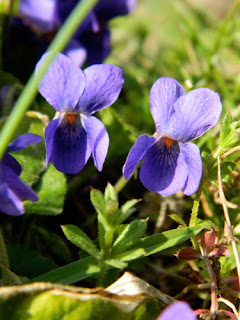 |
| Bittersweet Nightshade (Solanum dulcamara) |
A reoccurring theme
in the plant and garden forums I regularly frequent is parents that suddenly become concerned about the toxic plants in their yards and gardens. If you are one of them, I do applaud your concern, but I am sorry to say that there are many toxic plants that share the world with you. There may be ones in your yard, your gardens, the wild spaces around you, the parks you visit and more. And those plants were also in the lawns and gardens of your parents and you have grown to a healthy adulthood in spite of them! Just breathe. Relax. And read on.
So what is a parent to do? When my own children were tiny toddlers, I did not turn them loose outside unsupervised. I stayed with them, played with them, and taught them. Not only did I protect them from the dangers beyond just poisonous plants that could present themselves to such tiny ones, I developed a much closer bond with my children. What parent wouldn't want that?
As they grew older, more teaching crept in. One of the very first outdoor lessons was plant safety. At the time, bittersweet nightshade grew everywhere at our place. Rather than go crazy trying to obliterate every trace of this toxic plant,
as some parents in the forums I read would do, I took an alternate approach. I showed my children the plant with its brilliant red and rather appetizing looking berries. I explained that not all wild plants and berries were edible. In fact, some could make you sick and some could kill you. Their eyes grew big as that thought settled into their brains. The thought scared them - as well it should. I must say, I am not prone to exaggerating or "candy-coating" anything - my children learned that young. If I said it, I meant it and they believed it. They still do.
So, what did I do next? I taught them how to identify this plant by its distinctive leaves, clusters of fruit, and purple blooms with yellow stamens. They could identify the plant at our home as well as at the parks and hiking trails we visited - places where I certainly could not obliterate every toxic plant that existed! I gave them
power over this toxic plant. Further more, I also taught my children to never taste any unknown plant or fruits. They were to treat those plants and fruits as poisonous for they very well might be -- just like that nightshade they learned so well. They were only to eat wild plants and fruits if an adult they trusted (
I can't stress how key this is) told them the plant or fruit was safe.
 |
| Bittersweet berries |
In time and with age, they joined me in picking wild berries, wild herbs, and food from our gardens and u-pick farms. They learned how to identify those plants, when it was ripe, and what parts are usable. When I was absolutely sure they could ID those with no error, they began to pick their own without my direct supervision. My youngest loves picking wild blackcap raspberries, strawberries, and mulberries. Summer is his time for he is a huge berry lover. These skills will stay with them the rest of their lives and I am sure will pass to the next generation.
So my advice? Shield and protect closely when children are too young to accept safety lessons by staying with them outdoors. As they get older, teach them how to be safe rather than trying to "bubble wrap" their world. The lessons will serve them the rest of their life in your yard and way beyond it. That said, I strongly advise you do some research into the ornamental plants you want to add to your gardens. You may wish to avoid highly toxic plants like castor beans and monkshood until your children are much older. Or avoid them completely if poisonous plants give you pause.
Enjoy your gardens, enjoy your children, and enjoy the living world we are part of!
Be sure to learn more about bittersweet nightshade at the
Poison Garden website:
http://www.thepoisongarden.co.uk/atoz/solanum_dulcamara.htm





